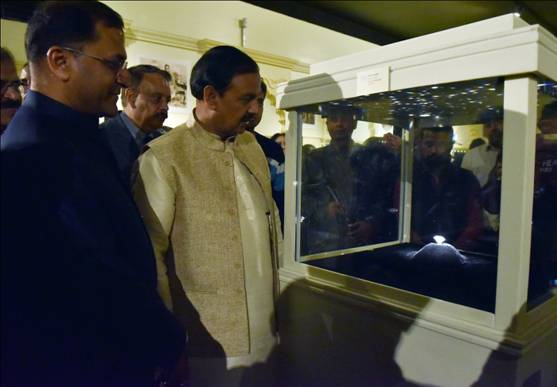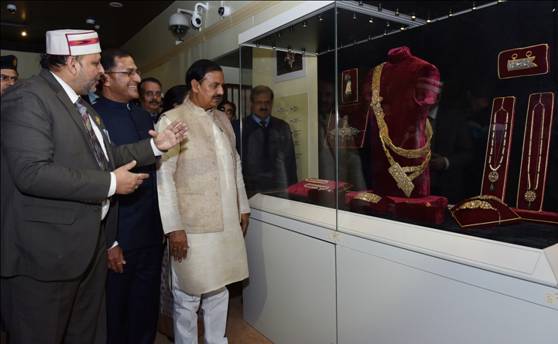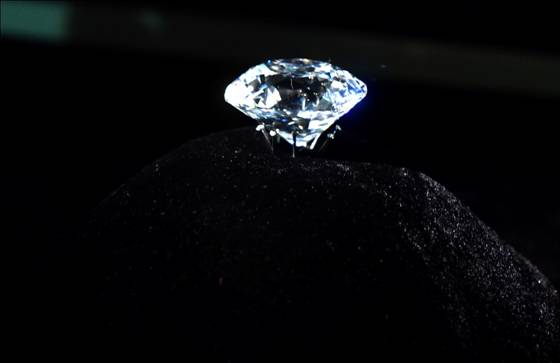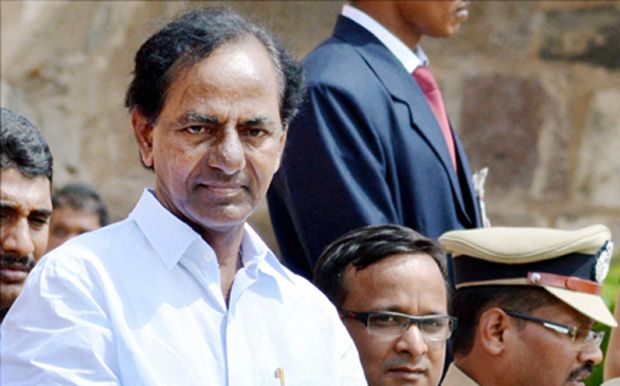C R GOWRI SHANKER
K Chandrasekhar Rao to get Nizam's jewellery
back to Hyderabad
Chief Minister, K. Chandrasekhar Rao reportedly held a preliminary discussion with senior officials and others and the matter will be pursued with the Centre shortly, it is learnt.
After yagam, K Chandrasekhar Rao to pursue
Nizam jewels
Dec 19, 2015, 7:46 am
Nizam’s jewels next target: CM
Chief Minister K. Chandrasekhar Rao said that the Nizam’s jewels would be a major tourist attraction of the state once they are brought back as they are famous worldwide.
“I will pursue with the Centre once priorities like 24-hour power supply, drinking water supply, two-bedroom housing scheme and others are on track,” he said.
Sources in the government said that a discussion had taken place a few months back regarding the jewels and a suitable place to house them. One such place is the banks of the Hussainsagar in the heart of the city.
“We did visualise a pearl shaped building on the banks of Hussainsagar to house the jewels. Of course, it needs the approval of the Central government, which is now the custodian of the jewels,” an official said.
N. Chandrababu Naidu, as Chief Minister of undivided AP, had pursued the issue of the Nizam’s jewellery with then Prime Minister Atal Behari Vajpayee, to relocate them to Hyderabad. He had almost succeeded but his government fell.
The Centre had even sent a team to identify a suitable location for the jewels and the state government had showed the Salarjung Museum, neighbouring Kela Mandi near Afzal Gunj, Health Museum in Public Gardens, Banjara Hills and a few other places.
The Central government wanted not only a suitable place, but also one with high security to protect the jewellery. But the subsequent state government did not follow up on the matter.
The Nizam’s jewels were a big hit with the public when they were displayed in New Delhi and Hyderabad.
Superb and rare, the 173 precious jewellery items of exquisite workmanship cover a period ranging from the 18th century to the early 20th century. It is one of the largest and richest collections of jewels in India.
It remained in the custody of the “H.E.H. Nizam Jewellery Trust” and “H.E.H. Nizam Supplemental Jewellery Trust” formed by the last Nizam, Mir Osman Ali Khan, in 1951-1952 to safeguard the ancestral wealth of the family. The trustees kept this treasure in the vaults of Hong Kong Bank.
Asked whether the government plans to pursue the issue again with the Centre, the official replied in the affirmative. “Yes, we will do it,” he added.
Princes Esra, former wife of the eighth Nizam Prince Mukarram Jah, who met Mr Rao on September 13 last year, had also requested the Chief Minister to bring back the jewels to Hyderabad.
Earlier, the state government had urged the Centre to bear the cost of land and building, but it was rejected.
The 173-set jewellery comprising 348 pieces was acquired by the Central government in 1995 after a long legal battle with the Nizam Trust which tried to sell the same after the death of Azam Jah.
The then Andhra Pradesh Chief Minister N. Chandrababu Naidu made a vain bid to bring the jewellery to Hyderabad for permanent display and even ensured a promise from then Prime Minister Atal Behari Vajpayee.
“Salarjung museum offered to house the jewellery in a new building on its premises provided the government handed over the nearby Darulshifa building and land for parking and also for location of a new Hyderabad museum. But the government did not respond,” an official disclosed.
The government later proposed the State Trading Corporation building on Road No. 3, Banjara Hills, but Intelligence Bureau officials, who visited the city for scouting of suitable sites, rejected it on security grounds. Since then the matter has not been pursued by the government.
There is talk that Nizam's family, especially Princess Esra objected to the display of jewels in Salarjung Museum since the Nizams were rulers and Salarjung was ‘only’ a Prime Minister. But a Salarjung Museum senior official denies it.
“I also heard about it but it is only a rumour. Neither Princess Esra nor any other Nizam family member had conveyed their objection to the government. I attended some official meetings pertaining to the jewellery and the issue did not figure.”
He added, “The proposal was to construct a new building in an open space on the museum premises. We requested the government to provide Darulshifa building and land. The government is at liberty to select any suitable place in the city to house the jewels. The Centre wants the state to have a suitable building and ensure proper security. The problem is that the issue is not being pursued seriously.”
Chiranjeevi wants Nizam jewels housed in Hyderabad
Hyderabad: Union tourism minister K. Chiranjeevi is keen to have the famous jewellery of the Nizams displayed in a museum in Hyderabad.
The fabulous jewellery, rated among the world’s priceless collections, was purchased by the Central government in 1995 for Rs 217 crore (the value would be 10 times more now) after long negotiations between the trustees and government.
The jewellery is currently stashed away in the RBI vaults, after it was exhibited a few times, because the Centre is undecided over where to display it.
Sources said Chiranjeevi plans to meet the PM and the CM to push for Hyderabad’s claim to host the collection.
His close aide said Chiranjeevi wanted the jewellery to stay in Hyderabad since it belongs to the erstwhile rulers of the then Hyderabad State. “He will take up the issue with the state and Central government,” the aide said.
source: http://www.DeccanChronicle.com / Home> News> Politics / by C. R. Gowri Shanker / DC, February 14th, 2013
History of Nizams' Jewellery
Superb and rare, as the collection comprising 173 precious jewels and jewellery items of exquisite workmanship is, it covers a period ranging from 18th century to the early 20th century.
The quantity of emeralds may run into a couple of thousand carats.
The value of this world renowned Jewellery is inestimable.
ARM BANDS
Fine Deccani Workmanship can be seen in these armbands. The use of silver outlines for the central diamonds and the deep red and green palette in the floral motifs in enamel on the back is manifest proof of the region.
This pair is made up of three hinged panels with openwork foliate design set with foiled table-cut diamonds.
Besides their spiritual values, jewels are greatly associated with the beauty as it is the woman who has been adorning herself by wearing them from the time immemorial.
BELT BUCKLE
This amazing belt buckle made in three parts hinged together for a better fit, has over 55 carats of diamonds, the central 5 weighing approximately 30 carats.
So fabulous is the collection of Nizams' Jewellery that it has created a stir, an unprecedented excitement and sensation among the people in India and gemologist all over the world.
EMERALDS
This is the collection of 22 unset emeralds weighing around 412 carats, the kind of which is not seen elsewhere.
PAIZEB
This pair of anklets (paizeb), in the form of interlocking vertical repeats hinged with each other set with old-cut Golcunda diamonds, with a crest of pearls along the upper edge. Along the lower edge pearl shaped drops set with foiled diamonds form a fringe.
The reverse is decorated with enamelling of the highest quality. The design follows typical Mughal designs of foliage in red and green with mauvish blue and white highlights.
Such ornaments of Mughal design were made for all important women of the Royal household.
SARPECH
(Turban Ornament)
This is the proud ornament that used to adorn Turbans in all the princely states of India. It turned out to be as a mark of high distinction among the royals. They appear quite often in the court of Nizam and the Sikh court of Maharaja Ranjit Singh.

THE JACOB DIAMOND
The Jacob diamond, believed to have been found as a rough stone in an African mine, was brought over by a Syndicate in Amsterdam where it was cut in a style that prevailed about 100 years ago.
THE SATLADA
Seven stringed Basrah Pearl Necklace commonly known as Satlada is yet another masterpiece that everybody would like to set his eyes at. It speaks beauty in true sense of the word.
Chow = Carat x Carat x 0.65 No. Of pearls
(Chow is an Arabic weight in trading the real pearls)
Courtesy: Government of India
Nizam Jewels
GOVERNMENT OF INDIA
JEWELLERY OF THE NIZAMS
HISTORY
Established by Mir Qamaruddin Asaf Jah I, the Nizams of Hyderabad belonged to the Asaf Jahi Dynasty who ruled from 1724 until 1948, when the erstwhile Hyderabad State was incorporated in the Union of India.
The Nizams of Hyderabad belonged to the Asaf Jahi dynasty established by Mir Qamaruddin Khan in the 1720s.
This dynasty traces its origins to the Mughal Empire.
During the reign of the Mughal Emperor, Muhammad Shah, he was given the governorship of Deccan in 1721 along with the title of “Asaf Jah”.
After just one year, Mir Qamaruddin came back to the north to become the Wazir.
In doing so, he transitioned from a loyal Mughal noble to a semi-independent ruler.
Even though detached from the imperial centre, he still recognized the over-lordship of the Mughal Emperor and never declared complete independence.
In this way, the Asaf Jahi dynasty was established in 1724.
However, it was only after defeating the Marathas in 1742 that the Nizam’s rule was properly established in the region.
His territory encompassed the entire plateau south of the Tapti river except for a narrow strip of land along the west coast ruled by the Marathas.
The Asaf Jahi empire also extended down till Trichinopoly (present day Tiruchirappalli) and Madurai and included the Golconda mines.
KEY PERSONALITIES
MIR NIZAM ALI KHAN - ASAF JAH II (1734-1803)
Nizam Ali Khan, Asaf Jah II, son of Asaf Jah I,
rose to power after succession problems.
The chaos of succession paved the way for
British and French powers to establish their own foothold in the Asaf Jahi
politics by supporting rival contenders.
The French supported Salabat Jung to become the
Nizam and the British incited Nizam Ali Khan, his brother, to rise in rebellion
against him.
In 1763, Nizam Ali Khan succeeded to the throne
and became the second Asaf Jah.
After becoming the Nizam, he shifted the capital
from Aurangabad to Hyderabad.
During Nizam Ali Khan’s reign, the British
gained political prominence in the Deccan. In 1795, Nizam Ali Khan was defeated
in a battle by Marathas.
To safeguard his position, he entered into the
Subsidiary Alliance with the British in 1798 which made him subservient to the
British power.
From 1799, a British Resident was stationed in
Hyderabad who supervised the governance of the state.
NIZAM MAHBOOB ALI KHAN - ASAF JAH VI (1866-1911)
Mahboob Ali Khan was merely two and a half years
old when he was declared the sixth Nizam.
He was formally acknowledged as the Nizam again
after attaining majority in 1884.
He is remembered for his extravagant lifestyle.
He went on elaborate hunts and hosted royal
guests like the Prince of Wales, the Duke of Connaught, Archduke Franz
Ferdinand of Austria, Grand Duke Alexander of Russia amongst others.
He was the first Nizam who wore western clothes
and conversed in English.
An entire wing of his palace was dedicated to
his magnificent wardrobe, the largest in the world. It is said that he never
wore the same suit twice!
He was called ‘Mahboob Pasha’ or 'Beloved King'
by the common people who also believed that the Nizam’s spirit was so holy that
a mere invocation of his name could ward off the poison of snake bite.
In 1908, when a disastrous flood hit Hyderabad
killing 15,000 people, the Nizam provided refuge to his subjects in his palace.
He also tried to appease the Hindu goddess
Bhavani by paying homage to the deity as it was popularly believed that her
anger incited the calamity. Being a Muslim ruler, this was an unusual move.
He died at the age of 45 in 1911.
NIZAM OSMAN ALI KHAN - ASAF JAH VII (1886-1967)
Mahboob Ali Khan was succeeded by his son, Mir
Osman Ali Khan, as the seventh and the last Nizam in 1911.
He was one of the richest men in the world.
A significant chunk of his wealth was
accumulated through nazar or valuable gifts offered to the
ruler by court attendees as an expression of respect and loyalty.
Nizam Osman Ali Khan made some significant
contributions to the Hyderabad state like the building of Osmania University,
Osmania Hospital, the State Central Library and the High Court.
He was one of the five Indian Princes who was
granted the highest salute of 21 guns by the British.
For his support to the British in the First
World War, he was conferred with the title of ‘His Exalted Highness.’
Nizam Osman Ali Khan decided to declare
Hyderabad an independent state on June 11 1947. This was not supported by the
Indian National Congress.
The Indian government negotiated with the Nizam
to incorporate the Hyderabad State into India but it failed to work out.
Thus, it launched an action code named ‘Operation Polo,’ in Hyderabad in 1948 following which the Nizam’s troops surrendered and the Hyderabad State was integrated into the Union of India.
GOVERNMENT OF INDIA
JEWELLERY OF THE NIZAMS
The jewels of the Nizams are one of the most magnificent collections in the world.
GEMS AND PRECIOUS STONES
Hyderabadi bazaars were resplendent with emeralds from Columbia, rubies and spinels from Burma and Sri Lanka, sapphires from Kashmir and pearls from the Gulf of Mannar and Bahrain. The following gems would feature most prominently:
DIAMONDOne of the 5 great stones, the diamond is indigenous to India.
Indian jewellers devised a variety of cuts (for example Kanval - lotus shaped) aimed at retaining the size of the gem while bringing out its brightness.
By custom, the best diamonds that came out of the Golconda mines had to be offered first to the Nizam as a gift or Nazar. Only if not accepted by the Nizam, could it be sold in the market.
- Despite not being indigenous to India, rubies were present in large numbers in traditional Indian ornamentation, particularly in Southern India due to strong trading relations between Burma and the ports on the Coromandel.
PEARLS
- Pearls or "Moti" are created by living shelled mollusks.
- In India, pearl fisheries used to be located off the coast of Thoothukudi (erstwhile Tuticorin) and they also were traded in large quantities from Bahrain and Iraq. Of special importance are the “Basra pearls”.
- Basra pearls are named after the town of Basra in Iraq as it was a centre of the global pearl trade since early medieval times.
- The natural Basra pearl is extremely rare and it was considered auspicious to even glance at it once in one’s lifetime.
- These pearls featured greatly in the Nizams’ jewellery collection.
JEWELLERY - TYPES
CHINTAK NECKLACE OR THE HYDERABADI COLLAR
This collar necklace is in the form of a series of rectangular plaques, each set with a pear-shaped table-cut diamond, within a green enamel border. A row of large Basra pearls are strung along the top, while the fringe below is made of drop-shaped elements set with diamonds, pearls and emerald beads.
The turban ornaments such as the sarpech were a symbol of divine monarchy.
Sarpatti (Turban Ornament)
This is a golden silver set with beautiful Golconda diamonds with polychrome enamelling on the back. The diamonds are exceptionally large.
This Kalgi has black enamelling on the back, typical of Deccani art. Beyond the Deccan, enamelling flourished in Kashmir and Himachal Pradesh. In contemporary times, Rajasthan is the hub for enamel work.
Sarpech (Turban Ornament)
Over time Kalgi and Sarpatti evolved to be combined into one composite jewel, the Sarpech. This is an emerald sarpech with carved emeralds inset with diamonds.
EARRINGSEarrings were worn by all genders and most classes within the society.
The following earrings were traditionally worn at the time, on different parts of the ear.
Karan Phool (Earrings)
It is in the shape of a flower with a jhumka at the bottom. The flower is suspended by two strings of pearl each including two emerald beads
Chowkarey (Earrings) or Pankhiyan (Earrings)
This intricate fan-shaped ornament is an example of the delicate craftsmanship of the Deccan. Uncut Golconda diamonds are studded into a gold circular base. Nine pearls are suspended from this. The base of each pearl features red enamelling in a flower pattern.
JEWELLERY - TYPES
CHINTAK NECKLACE OR THE HYDERABADI COLLAR
This collar necklace is in the form of a series of rectangular plaques, each set with a pear-shaped table-cut diamond, within a green enamel border. A row of large Basra pearls are strung along the top, while the fringe below is made of drop-shaped elements set with diamonds, pearls and emerald beads.
TURBAN ORNAMENTS
The turban ornaments such as the sarpech were a symbol of divine monarchy. They symbolized the privileged status of the Nizam. It had its own cycle of evolution from a simple feather, two separate jewels to a combined gem studded piece of jewellery. The earliest turban ornament dates back to the 18th century.
Sarpatti (Turban Ornament)
This is a golden silver set with beautiful Golconda diamonds with polychrome enamelling on the back. The diamonds are exceptionally large.
Kalgi (Turban Ornament)
This Kalgi has black enamelling on the back, typical of Deccani art.
Government of India
Ministry of Culture
18 FEB 2019 7:14PM by PIB Delhi
The Minister of State for Culture (IC), Dr. Mahesh Sharma inaugurated an exhibition of rare collection comprising 173 precious jewels and jewellery items of exquisite workmanship titled “Jewels of India: The Nizam’s Jewellery Collection”.
Shri Arun Goel, Secretary, Ministry of Culture; Dr. B. R. Mani, DG, National Museum and other senior officers of Ministry of Culture and National Museum were present on the occasion.
The exhibition has been organized by the National Mueseum, Ministry of Culture, Government of India. The exhibition has been curated by Shri Sanjib Kumar Singh and his team from the National Museum under the guidance of Dr. B. R. Mani, DG, National Museum.
Speaking on the occasion, Dr. Mahesh Sharma said that this is the third time that the Nizam’s jewellery has been put on public display before the people and especially the youth which will help them to familiarize with their rich cultural heritage.
The Ministry of Culture is continuously engaged in efforts to bring out the history of the country in parts and the rare exhibition is one such effort in this direction, the Culture Minister explained.
Dr. B. R. Mani, DG, National Museum said that it is the privilege of the National Museum to bring out the exhibition of such rare and precious gems and jewels belonging to the period ranging from 18th century to the early 20th century.
A portfolio on the Nizam’s jewellery collection and a booklet was also released on the occasion.
The Nizams' Jewellery is one of largest and rich collection of Jewels that was purchased in 1995 by the Government of India at a cost of Rs. 218 Crore.
The collection had remained in the custody of "H.E.H. Nizam Jewellery Trust" and "H.E.H. Nizam Supplemental Jewellery Trust" formed by the last Nizam Mir Osman All Khan in 1951-1952 to safe-guard the ancestral wealth of the family.
The trustees kept this treasure of great historical value in the vaults of Hong Kong Bank. When the Government of India acquired this collection in 1995, after a prolonged legal battle, it was shifted to the vaults of Reserve Bank of India (RBI), Mumbai, where it remained till 29th June 2001.
It was brought and kept in the vaults of the RBI, New Delhi, for safety and has now been shifted to the National Museum for a befitting display, the preparations of which are complete from all points of view including round-the-dock security.
The collection in-dudes, sarpeches, necklaces, belts and buckles, pairs of bracelets and bangles, earrings, armlets, toe rings, finger rings, pocket watch and watch chains, but-tons and cufflinks, etc.
While the diamonds from the celebrated mines of Golconda and Colombian emeralds predominate, the Burmese rubies and spinets and pearls from Basra and the Gulf of Mannar, off the east coast of India, will also form part of the Exhibition.
All the jewels are flamboyant, yet amidst the dazzle of precious gems, individual pieces stand out by virtue of their antiquity and the merit of their craftsmanship.
Most outstanding among this collection is the Imperial diamond now known as Jacob diamond, weighing 184.75 carats, which is a fabulous weight of any single gemstone. It is an invaluable sparkling diamond by all means, be its brilliant cutting, clarity and colour. It is almost double the size of Kohinoor Diamond (in the present shape).
Another item is a collection of 22 unset emerald pieces. Also an exceptionally large variety of cut emeralds, emerald drops, emerald beads, Taveez and many other shapes of Jewellery from Colombia and Russia and two ornamented belts, one studded with a cut and the other with a carved emerald have their own charm. The quantity of emeralds may run into a couple of thousand carats.
The beautiful seven stringed pearl necklace (satlarah) is a unique creation and its weight and size are simply mind-boggling.
There are approximately 40,000-50,000 chows (one chow = Carat x Carat x 0.65 /number of pearls) pearls in this collection. Besides, many necklaces with button pearls and diamond beads are exceptional for their extraordinary shape and cutting.
Most of the Jadau (stone-studded) items showing large, rose cut and flat cut diamonds total a few thousand carats in weight. Of the many rings with large diamonds of different colours, one set with a Alexandrite stone, perhaps from the famous Russian mines, is of unusually large size bearing testimony to the nature's excellent gift - it changes its colours sparklingly when viewed under artificial light.
The collection of pocket watch and watch chains studded with diamonds, emeralds and precious stones are noteworthy for their wide variety and intricate workmanship. It may be pointed out that some excellent enameled works from Jaipur, Delhi, Awadh and Deccan form part of this collection, which is comparable to the designs and details in the miniature paintings of these areas.
This exhibition is being organized for the third time to exhibit the Nizam’s Jewellery Collection. Prior to this, the Nizam’s jewellery was displayed twice at National Museum. The first exhibition was held in 2001 from 29th August – 15th September, 2001 in which 173 objects were put on display. The second exhibition was held from 26 Sept-30th December 2007.
The exhibition will remain open for public viewing from 19th Feb 2019 to 5th May 2019 from 10.00 AM to 6.00 PM (except Mondays and National Holidays). Entry by Special ticket of Rs.50/- per person.


(MoS Culture, Dr. Mahesh Sharma at the exhibition)

(Jacob diamond at the exhibition)
*****
NB/UD


































No comments:
Post a Comment